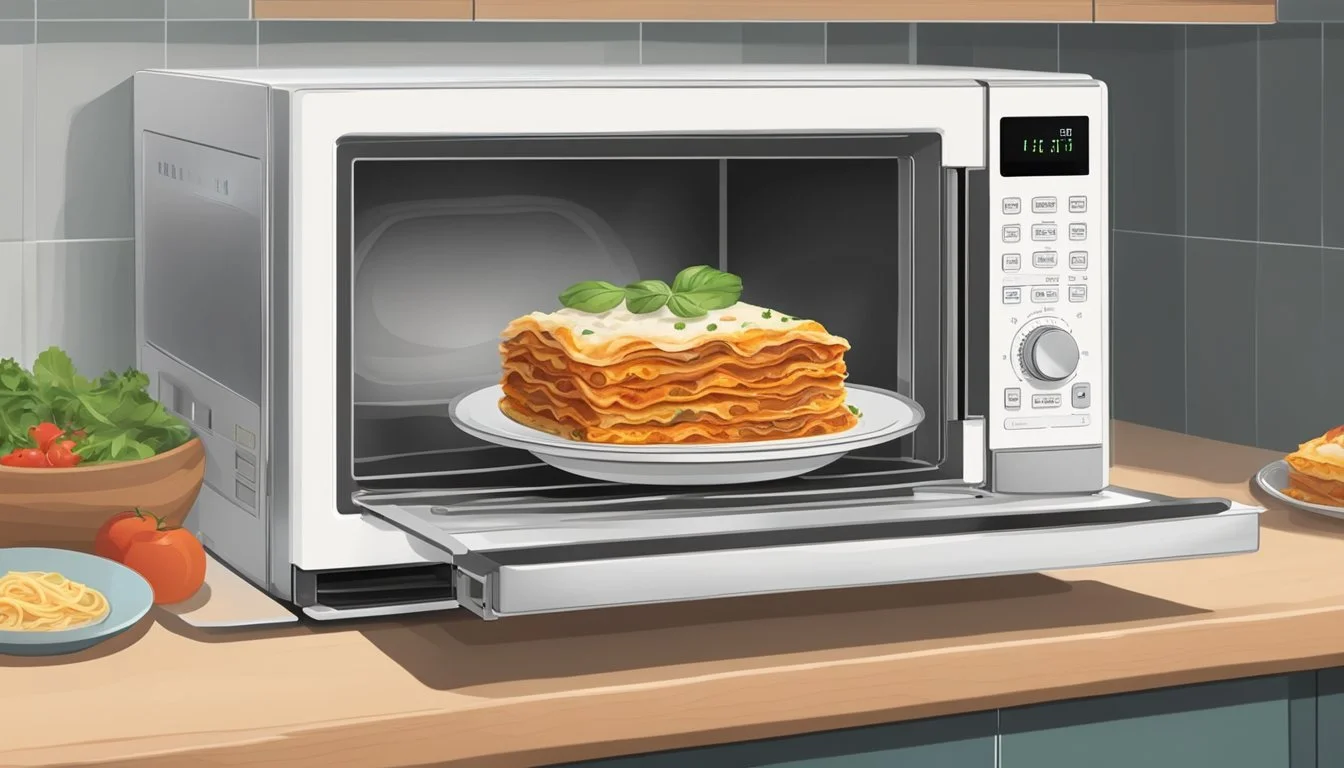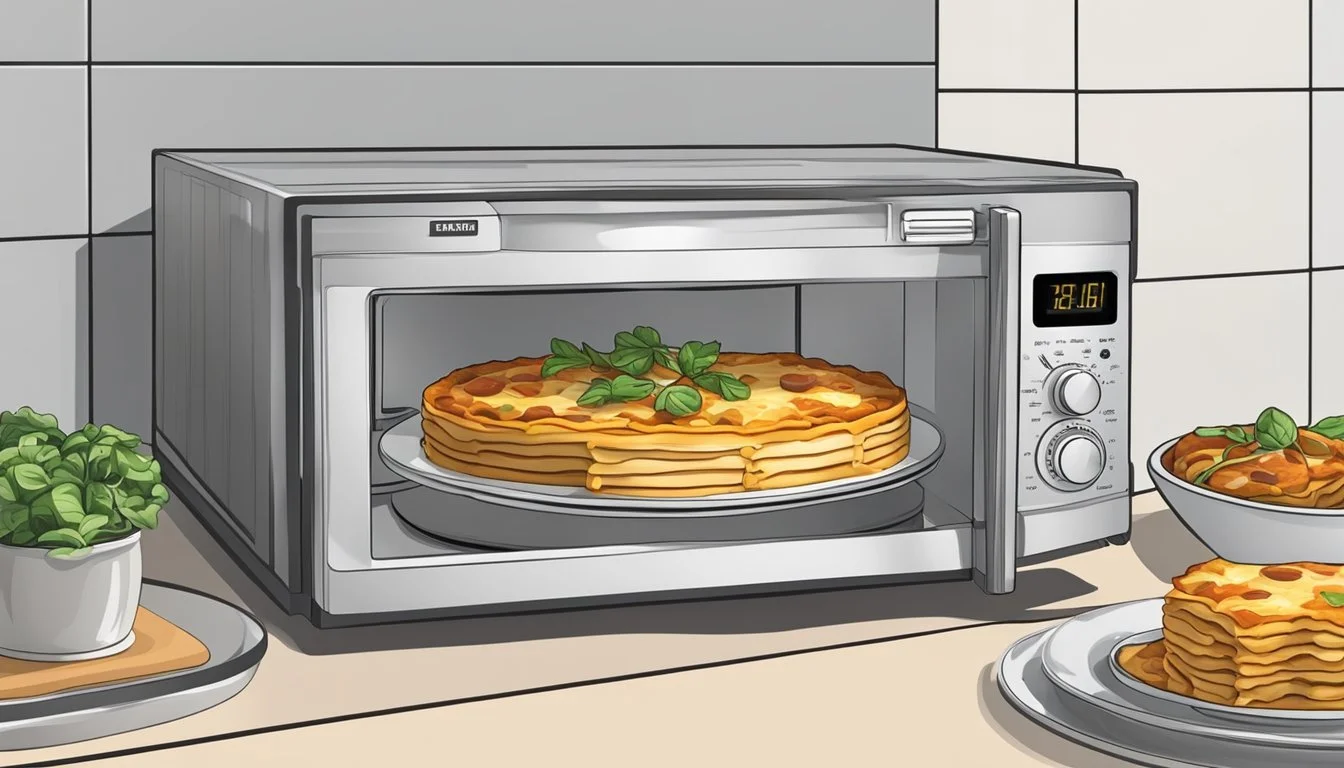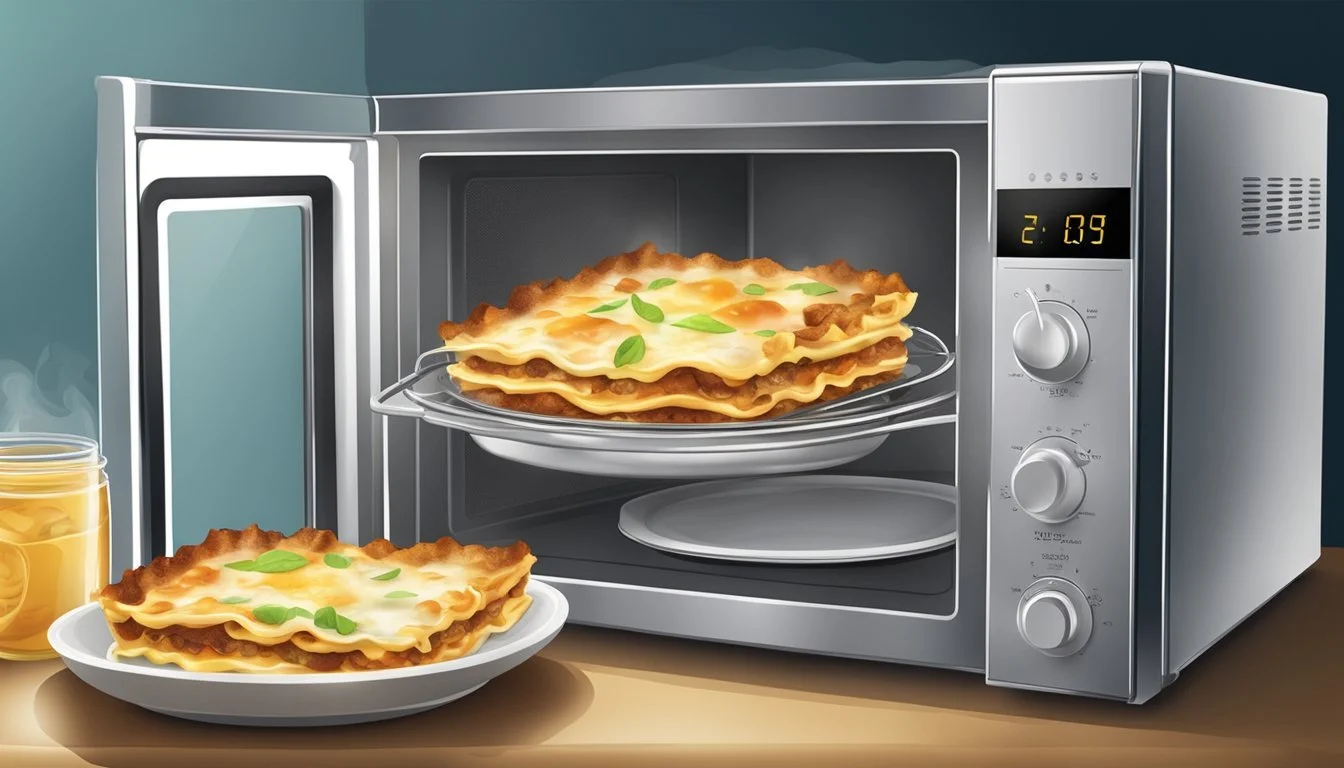How to Reheat Banquet Lasagna with Meat Sauce
Best Methods Explained
Reheating Banquet Lasagna with Meat Sauce can be a simple, yet crucial task to preserve its quality and delicious flavor. Whether using a microwave for convenience or the oven for a crispier texture, the method you choose can impact the meal's overall enjoyment. For the best results, ensure the lasagna reaches an internal temperature of 165°F (74°C) for safe consumption.
In the microwave, place the lasagna in a microwave-safe dish, sprinkle a bit of water or sauce to retain moisture, cover, and heat on medium power for one minute. Check and continue heating in 30-second intervals until hot. This quick method is perfect for one to two servings and keeps the lasagna moist and delicious.
For a more traditional approach, preheat the oven to 350°F, cover the lasagna with foil, and bake it on a baking sheet for 30-45 minutes. Check midway to avoid over-browning by tenting the foil if necessary. This method ensures a well-heated and evenly cooked dish, maintaining its rich, savory flavor.
Understanding Reheating Lasagna
When reheating lasagna, especially varieties like Banquet Lasagna with Meat Sauce, maintaining texture, and moisture is crucial. Proper temperature settings and moisture retention techniques ensure the lasagna remains delicious and safe to consume.
Overview of Reheating Methods
Oven: Preheat to 350°F (180°C). Cover the lasagna loosely with aluminum foil to prevent drying out. Bake for 20-25 minutes. Removing the foil for the last 5 minutes can help crisp the top.
Air Fryer: Preheat to 350°F (175°C) for five minutes. Cut the lasagna into individual portions. Place portions in an air fryer basket and heat for 5-7 minutes until warmed through.
Skillet: Place lasagna in a skillet with a lid. Add a small amount of water to maintain moisture. Cover and heat on medium-low for about 20 minutes, shaking occasionally.
Microwave: Place a portion on a microwave-safe plate. Cover with a microwave-safe lid or microwave plastic wrap. Heat on medium power for 3-5 minutes, checking halfway to ensure even heating.
Choosing the Right Reheating Temperature
Oven: 350°F (180°C) is ideal for even heating without drying out the meat sauce. Covering the dish with foil helps retain moisture.
Air Fryer: 350°F (175°C) ensures a quick, even heat. The compact environment helps prevent the drying of the meat sauce.
Skillet: Medium-low heat maintains a balance between heating and moisture retention.
Microwave: Medium power prevents overcooking and keeps the meat sauce juicy. High power might cause uneven heating and dryness.
Keeping the temperature consistent avoids overcooking and maintains the lasagna’s original texture and flavor.
Importance of Moisture Retention
Moisture prevents the lasagna from becoming dry and chewy. Adding a small amount of water or sauce can help maintain moisture.
Covering: Aluminum foil or lids trap steam, preserving moisture during reheating.
Monitoring: Checking halfway through the reheating process can prevent over-drying. Adjusting cover and timing can help maintain ideal moisture levels.
Resting: Allowing lasagna to rest post-reheating helps redistribute moisture evenly, making each bite consistent.
These techniques ensure the Banquet Lasagna with Meat Sauce remains as delectable as when it was first cooked.
Preparing Lasagna for Reheating
Before reheating banquet lasagna with meat sauce, it is crucial to assess its current state and add moisture to prevent drying.
Assessing Lasagna Condition
Examine the lasagna to determine if it's refrigerated or frozen. Frozen lasagna requires more time and sometimes a different method to reheat compared to refrigerated leftovers.
Check for dryness or freezer burn. If the lasagna appears dry, it's likely to dry out further during reheating.
Cut the lasagna into portions if not already separated. This allows for more efficient heating and ensures even temperature distribution.
Adding Moisture with Broth or Water
Add a small amount of water or broth to keep the lasagna moist. This step is vital to prevent the pasta from drying out during the reheating process.
Pour 1-2 tablespoons of water or broth around the edges and any areas that appear particularly dry.
Cover the dish with aluminum foil or a lid. This helps retain moisture and ensures even heating throughout the lasagna.
Consider using a baking dish if reheating multiple portions, as it allows for better coverage and moisture retention.
Oven Reheating Method
The oven reheating method ensures your Banquet Lasagna with Meat Sauce is heated evenly and retains its delicious texture. This approach involves using aluminum foil to keep the lasagna moist and setting the oven to the right temperature.
Covering Lasagna with Aluminum Foil
To prevent your lasagna from drying out, it is crucial to cover it with aluminum foil. Place the lasagna on a baking sheet to catch any drips.
Cover the dish snugly with a sheet of aluminum foil, making sure to seal the edges tightly. This traps the moisture inside, helping the lasagna maintain its moist texture. For a finishing touch, remove the foil during the last 5-10 minutes of reheating to allow the cheese on top to melt and become slightly crispy.
Setting Oven to the Correct Temperature
Preheat your oven to 375 degrees Fahrenheit (190 degrees Celsius) to ensure the lasagna heats evenly. This temperature is optimal for warming without overcooking.
Place the covered lasagna in the preheated oven. Bake for 25-30 minutes or until the internal temperature reaches 165 degrees Fahrenheit (74 degrees Celsius). Use a food thermometer to check, especially if reheating a large portion.
This method gives the best results, preserving the lasagna's texture and flavor.
Microwave Reheating Technique
Reheating Banquet Lasagna with Meat Sauce in a microwave involves covering the dish properly and monitoring the heating process to prevent overheating and dryness. Below are essential methods to achieve the best results.
Using Plastic Wrap to Cover
First, place the lasagna on a microwave-safe plate. Ensure the lasagna is evenly spread out to promote uniform heating.
Cover the lasagna with microwave-safe plastic wrap to trap steam. This method helps retain moisture, ensuring the lasagna remains tender.
Use a toothpick in the center of the lasagna to keep the plastic wrap from sticking to the sauce and cheese. Leave a small gap on one side to allow steam to escape, preventing the wrap from bursting.
Avoiding Overheating
Heat the lasagna at medium power to avoid cooking it too quickly. Start by microwaving it for 60-second intervals.
After each interval, check the temperature and stir slightly to distribute heat evenly.
Repeat this process until the lasagna reaches a safe internal temperature of 165°F. This approach prevents the edges from becoming rubbery while ensuring the center warms up thoroughly.
Let the lasagna sit for a minute before serving, allowing the heat to distribute uniformly.
Stovetop Reheating Strategy
Reheating Banquet Lasagna with Meat Sauce on the stovetop ensures even warming and retains moisture, resulting in a delicious meal.
Heating in a Skillet
To reheat lasagna effectively, use a cast-iron or non-stick skillet. Place the leftover lasagna slices directly into the skillet.
Drizzle about 1/4 cup of water around the slices to maintain moisture. This prevents the lasagna from drying out.
Set the heat to medium-high until the water starts to simmer. This method brings the lasagna to the ideal temperature without burning.
Pro tip: Use a skillet with a lid to cover the lasagna while reheating. This traps steam and enhances moisture retention.
Controlling Heat for Even Warming
To achieve even reheating, adjust the heat from medium-high to medium-low after the initial simmer.
Cover the skillet to let the lasagna heat thoroughly. Every few minutes, gently shake the skillet. This movement helps distribute the heat evenly.
After approximately 20 minutes, the lasagna should be fully warmed and moist. If a crispy bottom layer is desired, remove the lid for the last 5 minutes of cooking. Check the internal temperature to ensure it reaches at least 165°F (74°C) for food safety.
Alternative Reheating Appliances
For convenient and effective reheating, alternative appliances like air fryers and toaster ovens offer unique advantages. These methods can help maintain texture and flavor, making them viable options for reheating Banquet Lasagna with Meat Sauce.
Using an Air Fryer for Reheating
Air fryers provide a quick and efficient way to reheat lasagna. Start by preheating the air fryer to 350°F (175°C). This ensures even distribution of heat.
Slice the lasagna into individual portions and place them in the air fryer basket. Arrange the slices in a single layer to allow for proper air circulation.
Heat the lasagna for about 10-12 minutes. Check for desired warmth and crispiness. The air fryer prevents the lasagna from becoming soggy while keeping the edges crispy.
For best results, lightly cover the lasagna with aluminum foil if it tends to dry out. This method can quickly reheat frozen lasagna with minimal mess and maximum flavor retention.
Toaster Oven Reheating
A toaster oven can reheat lasagna effectively while preserving its texture. Preheat the toaster oven to 350°F (180°C). Use an oven-safe dish and place the lasagna slices in it.
Add a tablespoon of water or marinara sauce to the dish. Cover the lasagna with aluminum foil to prevent it from drying out. This step is crucial for maintaining moisture.
Reheat the lasagna for 20-25 minutes. Remove the foil during the last 5 minutes if a browned, crispy top is desired. Ensure the lasagna is thoroughly heated before serving.
This method allows for even heating and is ideal for those who prefer a crispy finish without compromising the lasagna's moisture and taste.
Post-Reheating Tips
Once the lasagna has been reheated, it is crucial to ensure it is safe to eat and achieves the best possible taste. Key points to focus on include checking the internal temperature and allowing the lasagna to rest before serving.
Checking Internal Temperature
After reheating, it is essential to verify that the lasagna has reached a safe internal temperature. Use a meat thermometer to measure the temperature at the center of the dish. The lasagna should ideally reach at least 165°F (74°C) to ensure that it is safe to consume.
If the temperature is below 165°F, return the lasagna to the heat and continue reheating. Check the temperature every few minutes until the desired temperature is achieved. This step is critical not only for safety but also to ensure the lasagna is warmed through and enjoyable to eat.
Resting Lasagna Before Serving
Patience is key after the lasagna has been heated. Allowing it to rest for about 5-10 minutes helps the flavors to meld and the texture to set. This resting period can make a significant difference in the overall taste and presentation.
Cover the lasagna loosely with aluminum foil during this time. This helps to retain the heat while preventing the top from drying out. After resting, the lasagna will be easier to cut and serve, offering a more satisfying dining experience.
By following these post-reheating tips, the banquet lasagna will be both delicious and safe to enjoy.
Storage and Safety Considerations
Proper storage and thawing techniques are essential for maintaining the quality and ensuring the safety of your Banquet Lasagna with Meat Sauce.
Storing Leftover and Frozen Lasagna
Leftover lasagna should first be allowed to cool at room temperature for about 30 minutes. Hot food placed directly into the refrigerator can raise the temperature, risking spoilage. Once cooled, store lasagna in airtight containers or wrap it tightly with heavy-duty aluminum foil.
For refrigeration, the lasagna should be kept at a temperature of 40°F (4°C) or below and consumed within 3-5 days. Freezing lasagna extends its shelf life considerably. To freeze, portion the lasagna into meal-sized servings and store it in freezer-safe containers or heavy-duty freezer bags.
Thawing Techniques for Frozen Lasagna
Thawing frozen lasagna properly is crucial to ensure it heats evenly and maintains its taste and texture. One recommended method is to transfer the lasagna from the freezer to the refrigerator. Allow it to thaw slowly over 24 hours. This gradual thawing helps retain moisture and prevents the lasagna from becoming dry.
If you need to thaw it more quickly, you can use the defrost setting on a microwave. Alternatively, place the frozen lasagna, still wrapped, in cold water, changing the water every 30 minutes. Ensure the lasagna is thawed completely before reheating to achieve the best results.
Enhancing Reheated Lasagna
Enhancing reheated lasagna involves a mindful approach to complementing flavors and introducing fresh elements. By choosing the right side dishes and incorporating fresh herbs and spices, the dining experience can be elevated.
Choosing Complementary Side Dishes
When reheating Banquet Lasagna with Meat Sauce, pairing it with the right sides can create a balanced meal. A side salad with mixed greens, cherry tomatoes, and a light vinaigrette adds freshness. Additionally, a simple garlic bread made with olive oil, garlic, and parsley can enhance flavors and provide a satisfying crunch.
Another ideal side is roasted vegetables such as zucchini, bell peppers, and eggplant, seasoned with salt, pepper, and oregano. These vegetables complement the heartiness of the lasagna. For a creamy contrast, consider serving a Caesar salad with Parmesan cheese and croutons, which pairs well with the cheese and sauce of the lasagna.
Adding Fresh Herbs and Spices
To elevate the flavor of reheated lasagna, incorporating fresh herbs and spices is essential. Basil and parsley bring a fresh, vibrant taste. Sprinkling these herbs on top just before serving can enhance the overall flavor profile.
Oregano and red pepper flakes can add depth and a hint of spice. For those who enjoy a bit of zest, a light drizzle of olive oil mixed with minced garlic and lemon zest can also be applied.
Cheese is another critical element. Adding freshly grated Parmesan cheese or melted mozzarella on top during the last few minutes of reheating can create a gooey, rich finish. This not only enhances the texture but also reinforces the cheesy goodness of the lasagna.
Conclusion
Successfully reheating Banquet Lasagna with Meat Sauce requires a blend of effective techniques and culinary creativity. Ensuring it remains moist and flavorful is crucial.
Using the oven is highly recommended to prevent drying out. Cover the lasagna with aluminum foil and heat it at 350°F (175°C) for 20-25 minutes. This maintains the delicious layers of pasta, cheese, and meat sauce.
For a quicker option, the microwave can be used. Place a microwave-safe cover over the dish and heat it in increments of 1-2 minutes. This helps maintain its moisture and prevents overcooking.
An air fryer can also be used for a crispier texture. Set it at 350°F (175°C) and heat for 8-10 minutes. This method adds a delightful crunch to the edges.
Remember, reheating lasagna too many times may degrade its quality. It's best to reheat it only once to keep the flavors and textures intact.
For those interested in culinary creativity, consider adding a bit of ricotta or extra cheese before reheating. This can enhance the creamy texture and flavor, making the dish even more enjoyable.
Incorporating these techniques will help ensure that the lasagna tastes just as good as the day it was prepared.








